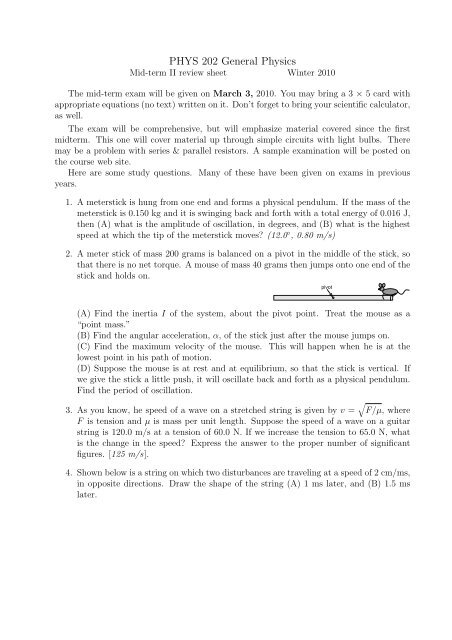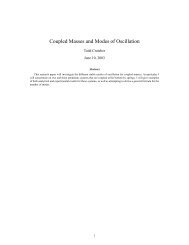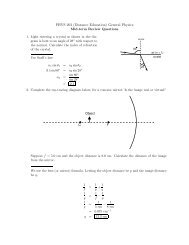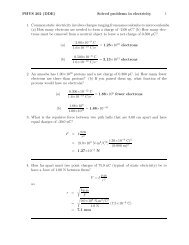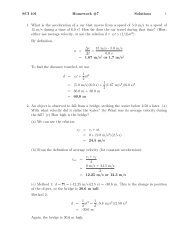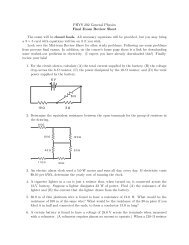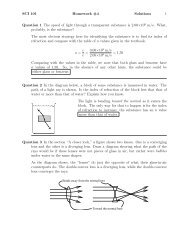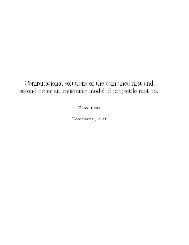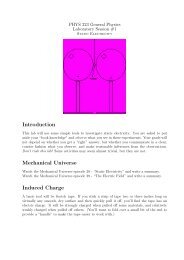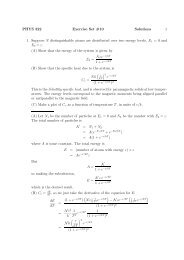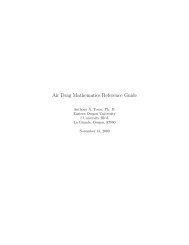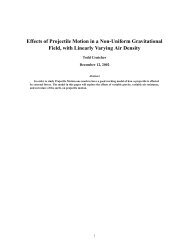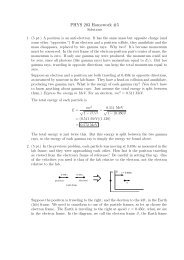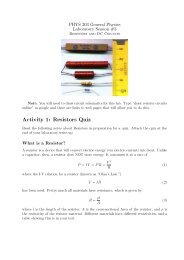PHYS 202 General Physics
PHYS 202 General Physics
PHYS 202 General Physics
Create successful ePaper yourself
Turn your PDF publications into a flip-book with our unique Google optimized e-Paper software.
<strong>PHYS</strong> <strong>202</strong> <strong>General</strong> <strong>Physics</strong><br />
Mid-term II review sheet Winter 2010<br />
The mid-term exam will be given on March 3, 2010. You may bring a 3×5card with<br />
appropriate equations (no text) written on it. Don’t forget to bring your scientific calculator,<br />
as well.<br />
The exam will be comprehensive, but will emphasize material covered since the first<br />
midterm. This one will cover material up through simple circuits with light bulbs. There<br />
may be a problem with series & parallel resistors. A sample examination will be posted on<br />
the course web site.<br />
Here are some study questions. Many of these have been given on exams in previous<br />
years.<br />
1. A meterstick is hung from one end and forms a physical pendulum. If the mass of the<br />
meterstick is 0.150 kg and it is swinging back and forth with a total energy of 0.016 J,<br />
then (A) what is the amplitude of oscillation, in degrees, and (B) what is the highest<br />
speed at which the tip of the meterstick moves (12.0 ◦ , 0.80 m/s)<br />
2. A meter stick of mass 200 grams is balanced on a pivot in the middle of the stick, so<br />
that there is no net torque. A mouse of mass 40 grams then jumps onto one end of the<br />
stick and holds on.<br />
pivot<br />
(A) Find the inertia I of the system, about the pivot point. Treat the mouse as a<br />
“point mass.”<br />
(B) Find the angular acceleration, α, of the stick just after the mouse jumps on.<br />
(C) Find the maximum velocity of the mouse. This will happen when he is at the<br />
lowest point in his path of motion.<br />
(D) Suppose the mouse is at rest and at equilibrium, so that the stick is vertical. If<br />
we give the stick a little push, it will oscillate back and forth as a physical pendulum.<br />
Find the period of oscillation.<br />
√<br />
3. As you know, he speed of a wave on a stretched string is given by v = F/µ, where<br />
F is tension and µ is mass per unit length. Suppose the speed of a wave on a guitar<br />
string is 120.0 m/s at a tension of 60.0 N. If we increase the tension to 65.0 N, what<br />
is the change in the speed Express the answer to the proper number of significant<br />
figures. [125 m/s].<br />
4. Shown below is a string on which two disturbances are traveling at a speed of 2 cm/ms,<br />
in opposite directions. Draw the shape of the string (A) 1 ms later, and (B) 1.5 ms<br />
later.
v<br />
2 4 6 8 10<br />
x, cm<br />
V<br />
x, cm<br />
5. Pick one: waves do not transmit (a) information, (b) mass, (c) energy.<br />
6. Sound travels through the air at a speed of 343 m/s at room temperature. Suppose a<br />
flute plays a high “E” (f = 677 Hz). What is the wavelength of this sound in air [0.507<br />
m] Suppose this sound were transmitted into water. Would you expect the wavelength<br />
to get shorter or longer Explain.<br />
7. A violin string 40 cm long vibrates at a frequency of 660 Hz, which is its fundamental<br />
frequency. What is the velocity of a wave traveling along this string [528 m/s.] If we<br />
now touch the string 1/3 of the way from the end, so that a node appears there, what<br />
is the frequency of the vibration<br />
8. The sound intensity of normal conversation is about 3.2×10 −6 W/m 2 . (a) What is the<br />
sound power level in dB The sound power level in Mac’s Grill at lunchtime is 70 dB.<br />
What is the ratio of the intensities (in W/m 2 ) of these two sound levels [3.1]<br />
9. A siren on top of a pole emits a sound at 300 Hz. A person 30 m from the pole hears<br />
the sound at a sound level of 70 dB. (A) What is the sound power (in dB) at a point<br />
120 m from the pole Assume that the intensity obeys the inverse square law. [58 dB]<br />
(B) For a 70-dB sound, the amplitude P A of the pressure variation is 0.091 N/m 2 . For<br />
the 300 Hz, 70-dB sound, write an equation for pressure as a function of time, of the<br />
form<br />
P = P A cos (ωt) .<br />
10. A tube 2.0 m long is open at both ends. What is the lowest frequency for a standing<br />
wave in this tube (That is, what is the lowest resonant frequency) [86 Hz] What<br />
would the lowest resonant frequency be if the tube were closed on one end Why are<br />
organ pipes closed on one end<br />
11. Again, a 2.0-m-long tube is open at both ends. A standing wave is set up inside the<br />
tube, so that there are three displacement nodes inside the tube. Draw a diagram<br />
showing the node-antinode pattern, and find the frequency of the standing wave. [257<br />
Hz].
12. Two tuning forks are played together, and a beat frequency of 4.0 Hz is heard. One of<br />
the tuning forks has a frequency of 256 Hz. What possible frequencies could the other<br />
tuning fork have<br />
13. Suppose two cars have horns which produce identical sounds with a single frequency<br />
of 300 Hz. One of the cars is stopped beside the road, and other other car passes it<br />
at some speed, coming toward you, the observer. When they are close together, both<br />
cars sound their horns, and you hear a beat frequency of 8.0 Hz. At what speed is the<br />
moving car traveling Assume the speed of sound is 343 m/s. [8.9 m/s].<br />
14. Point charges +Q and -4Q are separated a distance of 10 cm, and the force between<br />
them is 6.0 N. We now increase the distance to 30 cm. What is the new force<br />
15. Suppose a charge -Q is sitting at the corner of a square of side l = 1.00 m, and an<br />
electron is sitting at the opposite diagonal corner, as shown. In addition, two positive<br />
charges Q are at opposite corners of the square. The magnitude of Q is 3.00 µC. (A)<br />
Determine the electric field (magnitude and direction) at the electron’s position. (B)<br />
Determine the force on the electron. (24,600 N/C, 3.9×10 −15 N)<br />
+Q<br />
-e<br />
-Q +Q<br />
16. An electron located near a plate at potential -10 V in a vacuum is released and moves<br />
toward a plate at ground potential (0 V). When the electron hits the second plate,<br />
what is its kinetic energy in electron volts What is its speed (1.88×10 6 m/s). Is<br />
there enough information here to determine how much time it took the electron to<br />
move from one plate to another<br />
17. An electric alarm clock used a 5.0-W motor and runs all day, every day. If electricity<br />
costs $0.10 per kWh, determine the yearly cost of running the clock. ($4.38)<br />
18. A cigarette lighter in a car is just a resistor that, when turned on, is connected across<br />
the 12-V battery. Suppose a lighter dissipates 33 W of power. Find (A) the resistance<br />
of the lighter and (B) the current that the lighter draws from the battery. (4.4 Ω, 2.8<br />
A)
19. In the circuit shown, identical light bulbs are connected to a battery which maintains<br />
a constant potential between points 1 and 2. What happens to the brightness of each<br />
bulb if bulb B is removed from its socket The circuit is now restored to its original<br />
condition. What happens to the brightness of each bulb if bulb A is removed from its<br />
socket Bulb A is now replaced. What happens to the brightness of each bulb if we<br />
now connect a wire between points 2 and 4<br />
A<br />
5<br />
B<br />
4<br />
C<br />
3<br />
1 2<br />
20. For the circuit shown, calculate (A) the total current supplied by the battery, (B) the<br />
voltage drop across the 6- Ω resistor, (C) the power dissipated by the 10- Ω resistor,<br />
and (D) the total power supplied by the battery.<br />
6 V<br />
6 Ω<br />
10 Ω 3 Ω<br />
21. 30.0 m of thin platinum wire is found to have a resistance of 12.0 Ω. What would be<br />
the resistance of 100 m of the same wire What would be the resistance of the 30-m<br />
piece if you folded it in half and connected the ends, to form a conductor 15.0 m long<br />
(3 Ω)<br />
22. A certain battery is found to have a voltage of 28.0 V across the terminals when<br />
measured with a voltmeter. (A voltmeter requires almost no current to operate.)<br />
When a 120- Ω resistor is connected across the terminals of the battery, the voltage<br />
drop across the resistor is found to be 25.5 V. Determine the internal resistance of the<br />
battery. Predict what the voltage between the battery terminals would be if we hooked<br />
a 40- Ω resistor between the terminals. (11.8 Ω, 21.6 V)<br />
23. Why can a bird sit on a high-voltage power line and not be shocked
24. Here is drawn a circuit involving a battery and a light bulb. What will happen if we<br />
“ground” a terminal of the light bulb by hooking to a metal pipe stuck in the ground<br />
Explain.<br />
PIPE<br />
25. A typical NiCad cell has voltage of 1.28 volts and a charge capacity of 1400 mA-hours.<br />
Suppose we hook two of these cells in series, and connect them to a light bulb which<br />
has a “hot” resistance of 9.0 Ω. What is the current through the bulb How much time<br />
could the NiCad cells keep this bulb lit How much charge in C would pass through<br />
the bulb in that time How much energy does the bulb dissipate in that time (0.28<br />
A, 4.9 hours, 5040 C, 12,900 J).<br />
26. In the circuit below, all bulbs are identical. Rank the bulbs in order of brightness. If<br />
two bulbs are equally bright, indicate so. The battery supplies a total of 0.80 amperes,<br />
and the current through bulb B is 0.25 amps. Find the current through bulb D.<br />
A<br />
D<br />
B<br />
C<br />
E


